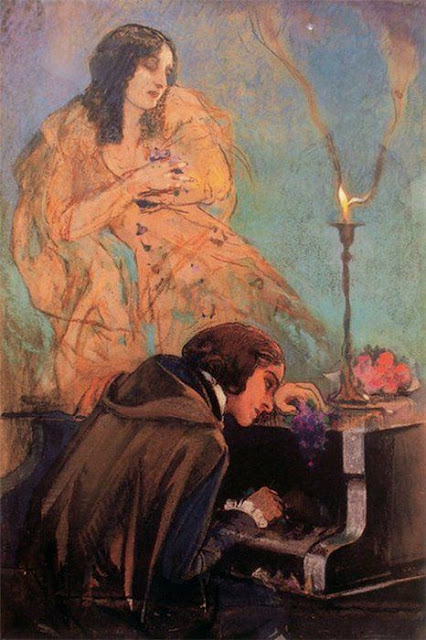Romantic artists prefer diagonal lines, circles, bends and swirls. Also darker colors and
foggy or stormy skies (and oceans).
They use less-distinct, often smudged or blurred outlines for the figures.
They use more decoration and often create busier (more complex) works.
They use less-distinct, often smudged or blurred outlines for the figures.
They use more decoration and often create busier (more complex) works.
Hellenistic Art (c. 350 - 30 BCE) (Romantic)
Characteristics: Drama, death, fantasy
Gothic Art - 1150 - 1400
Characteristics: Emotional, Magical, Mysterious, Fantastical
Simone Martini (c. 1285)
Baroque Art - c. 1600
After the classicism of the Renaissance which featured values such as high morals, the intellect over the passions, courage, calmness, optimism, prudence and civic mindedness,
Baroque art's romanticism includes (motion) action, drama, passion, anguish, foreboding, turbulence, chaos, tragic charter flaws, the mysterious and the magical. Greek mythology is a recurrent theme.
Gian Lorenzo Bernini - David - 1623 - 1624
19th Century Romantic Art - c. 1800 - 1850
William Blake - English
Caspar David Friedrich - German
Théodore Géricault - French
Eugene Delacroix - French

Thomas Cole - American
Baroque Art
Gian Lorenzo Bernini - David - 1623 - 1624
El Greco - View of Toledo - c. 1599
Caravaggio - The Taking of Christ - 1602
Peter Paul Rubens - The Fall of Phaeton - 1604
Baroque Architecture
Later Baroque architecture is dominated by rococo. It is busy, highly ornamental, complex, and often an overload of sensuality.
Asamkirche, Munich - 1733 - 1746
Palace of Versailles
The Baroque Theatre
19th Century Romantic Art - c. 1800 - 1850
William Blake - English
Nebuchadnezzar
(Isaac) Newton
Caspar David Friedrich - German
Wanderer Above a Sea of Fog
The Raft of Medusa (1818)
Eugene Delacroix - French
Frederic Chopin & George Sand
Gustav Courbet - French

The Desperate Man (1848)
J.M.W. Turner - English
Dutch Boats in a Gale
Thomas Cole - American
Prometheus Bound



















No comments:
Post a Comment